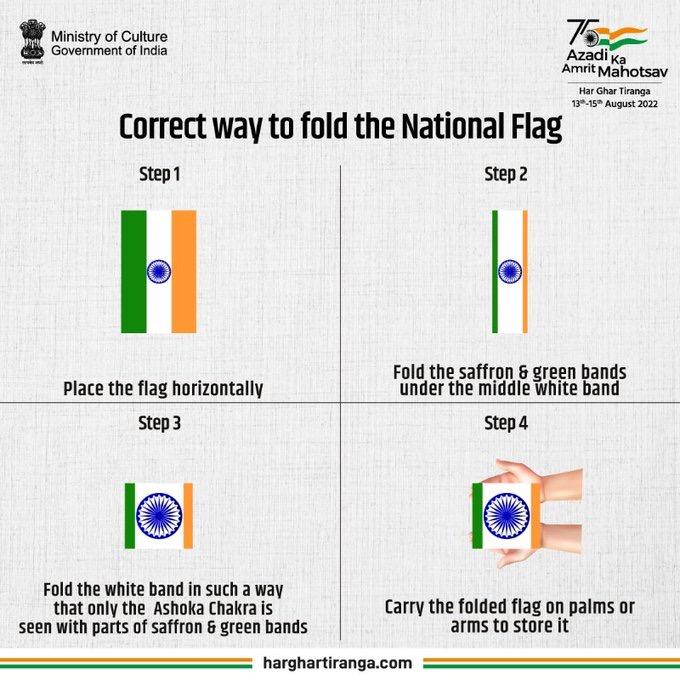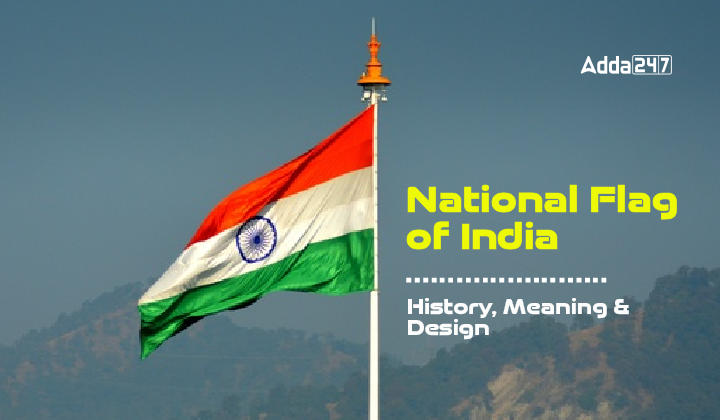Table of Contents
The National Flag of India: The National Flag of India has a horizontal tricolor of deep saffron at the top, white in the middle and dark green in the bottom in equal proportion. In the centre of the white band is a navy blue circle with 24 spokes which represents a chakra. The Indian tricolour has great significance in terms of history and cultural connotations attached to it. It is a symbol of freedom.
The flag came into being on the 22nd of July 1947 and is known as the Indian tricolour. For many years even before independence, a flag of a similar nature was being used. And the three colours were prominent in the various designs that were proposed as well as the ones that came into being used as part of the freedom struggle. It’s not just a mere simple piece of cloth that we salute on every occasion of National interest like Republic Day or Independence Day.
National Flag of India and Its Symbolism
The flag is symbolic of valour, prosperity, peace, and progress, which is depicted in the three colours and the Ashok chakra in the middle. It was designed by Pingali Venkayya and is the country’s pride ever since. It is made of Khadi, which is a handspun cloth to celebrate the Indian weavers, and Gandhiji wanted to popularise the usage of this cloth and to make the people of India self-reliant.
National Flag of India and Its History
During the British regime, the British flag was flown from all headquartered cities in India. This generated a further urge to get back our land from the clutches of foreigners and establish our own sovereign nation with its own flag.
Several flags were used before independence, and they contained more of the ruling country and very less of the country they occupied. None of the flags did true justice to the land until our very own tricolour came into being. It gave the people pride to have their own flag and be able to defend the pride of the nation by keeping the flag always flying high. Every independent country having a flag of their own has representation in any forum through its flag, be it a world body, sporting event, or any other platform. The flag showcases the country it represents through the colours and symbols on it.
National Flag of India Code
There is a specific flag code laid out for hoisting, de-hoisting, and storing the flag when not in use. The flags cannot be used by private citizens other than in the Independence and republic days, through recent amendments allow for a little more freedom of usage subject to protocols.
Some specifications have to be followed when flags are manufactured such as
- Flag size
- Dye color
- Chromatic values
- Brightness
- Thread count
- Hemp cordage
National Flag of India & Its Design
The National flag of India is a horizontal tricolour flag with saffron (Kesari) colour at the top, white in the middle and dark green at the bottom in equal proportion. The ratio of the width of the flag to the length of the flag is 2:3.In the centre of the white band is a navy-blue wheel that represents the chakra. Its design resembles that of the wheel on the abacus of the Sarnath Lion Capital of Ashoka. The diameter of the Ashoka Chakra diameter approximates to the width of the white band and it has 24 spokes.
Different colours symbolize different meanings in the national flag:
- Safron is for the sacrifice and courage of the people. It also marks the renunciation of greed and the need to work for the country.
- White is for peace and truth. It is the path of light and guides our conduct.
- Green symbolized prosperity, which depicts the plant life, and sustenance of the people.
The wheel symbolises progress and dharma. It is the protector of the truth and guided by the law of the land.
The weaving of the flag doesn’t conform to the conventional khadi weaving, and only some specialists are skilled in doing the particular weaving required to spin khadi for the flag. As of today, only a handful of weavers can deliver a particular quality that can be used to make the Indian tricolour.
- 150 threads/sq.cm
- 4 threads/stitch
- 1 sq.ft = 205gms
The largest size of the flag could = 6300x4200mm
The smallest size of the flag could be = 150x100mm
The code suggests that there has to be no improper usage of the flag, prevention of insults, etc. punishable by law with both fines and imprisonment of three years.
National Flag of India: The Do’s
- The National Flag may be hoisted in educational institutions on special occasions, ceremonial or otherwise consistent with the dignity and honour of the National Flag.
- Section 2 of the new code accepts the right of all private citizens to fly the flag on their premises.
National Flag of India: The Don’ts
- The National flag cannot be used for communal gains, drapery, or clothes. It should be flown from sunrise to sunset, irrespective of the weather.
- The National flag cannot be intentionally allowed to touch the ground or the floor or trail in the water. The flag cannot be draped over the hood, top, and sides or back of vehicles, trains, boats or aircraft.
- No other flag can be placed higher than the national flag. No object, including flowers garlands or emblems, can be placed on or above the flag.
- The national flag cannot be used as a drapery or clothing.
How to Fold the National Flag of India?
The Ministry of Culture has explained in detail how to fold the National Flag of India in a tweet recently. The people of India must go through a detailed explanation of how to fold the National Flag of India to be able to fold the Indian National Flag with dignity and respect. Read the instructions given below carefully to know more.
- The Indian National Flag must be placed Horizontally (not on the floor or any other undignified place).
- The saffron and green band of the National Flag must be folded beneath the white band.
- Further, the National Flag of India must be folded in such a manner that only the Chakra is visible with slight parts of safron and green.
- Finally, the folded Indian National Flag must be carried in arms or palms to be stored in a safe and dignified place.




 UGC NET Commerce Subject Combination, Ch...
UGC NET Commerce Subject Combination, Ch...
 AP SET Exam Centre 2024, District and Lo...
AP SET Exam Centre 2024, District and Lo...
 BPSC Teaching Exams Calendar 2024 Releas...
BPSC Teaching Exams Calendar 2024 Releas...








